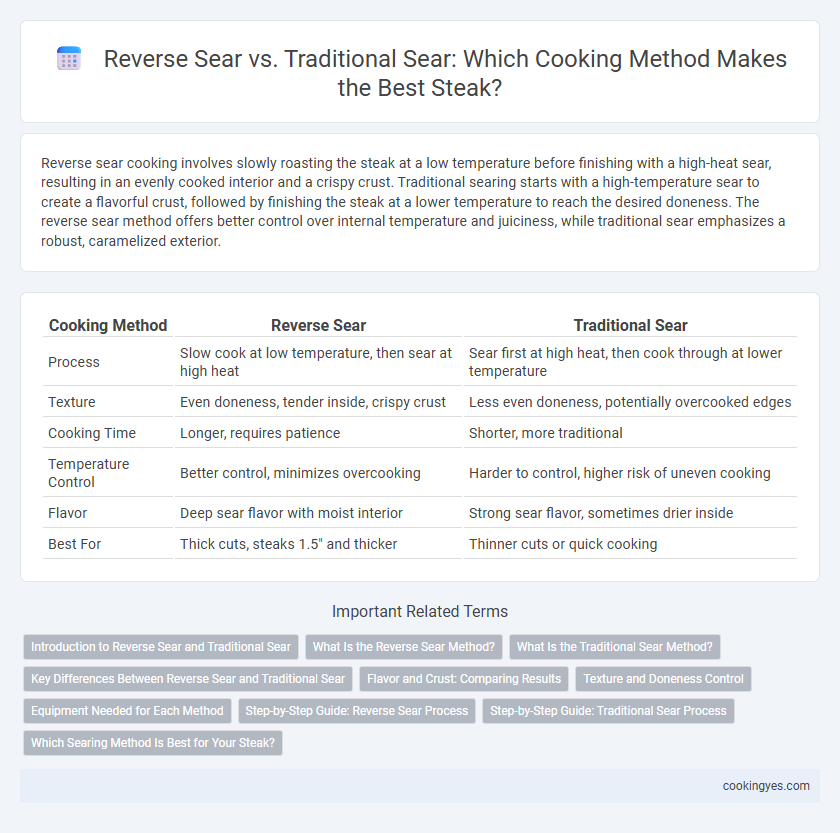Reverse sear cooking involves slowly roasting the steak at a low temperature before finishing with a high-heat sear, resulting in an evenly cooked interior and a crispy crust. Traditional searing starts with a high-temperature sear to create a flavorful crust, followed by finishing the steak at a lower temperature to reach the desired doneness. The reverse sear method offers better control over internal temperature and juiciness, while traditional sear emphasizes a robust, caramelized exterior.
Table of Comparison
| Cooking Method | Reverse Sear | Traditional Sear |
|---|---|---|
| Process | Slow cook at low temperature, then sear at high heat | Sear first at high heat, then cook through at lower temperature |
| Texture | Even doneness, tender inside, crispy crust | Less even doneness, potentially overcooked edges |
| Cooking Time | Longer, requires patience | Shorter, more traditional |
| Temperature Control | Better control, minimizes overcooking | Harder to control, higher risk of uneven cooking |
| Flavor | Deep sear flavor with moist interior | Strong sear flavor, sometimes drier inside |
| Best For | Thick cuts, steaks 1.5" and thicker | Thinner cuts or quick cooking |
Introduction to Reverse Sear and Traditional Sear
Reverse sear involves slow-cooking steak at a low temperature before finishing with a high-heat sear, ensuring even doneness and a tender interior. Traditional sear starts by searing the steak directly on high heat to create a crust, followed by cooking to desired doneness. Both methods utilize Maillard reaction for flavor development but differ in heat application and timing.
What Is the Reverse Sear Method?
The reverse sear method involves cooking steak slowly at a low temperature before finishing with a high-heat sear to achieve a uniform medium-rare interior and a crispy crust. This technique enhances flavor development by allowing even heat distribution and better moisture retention compared to the traditional sear method, where the steak is cooked quickly over high heat first. Reverse searing is particularly effective for thick cuts like ribeye or filet mignon, producing tender, juicy results with a caramelized outer layer.
What Is the Traditional Sear Method?
The traditional sear method involves cooking a steak directly on high heat to create a caramelized, flavorful crust while locking in juices. This technique typically begins by placing the steak on a hot grill or pan, searing each side for a few minutes before finishing at a lower temperature if needed. The key to traditional searing is maintaining intense direct heat to achieve Maillard reaction, which enhances the steak's texture and taste.
Key Differences Between Reverse Sear and Traditional Sear
Reverse sear involves slowly cooking the steak at a low temperature before finishing with a high-heat sear, ensuring even doneness and a consistent pink center. Traditional sear starts with a high-heat sear to develop a crust, followed by cooking the steak to the desired temperature, which can sometimes lead to uneven doneness. The key differences lie in temperature control, cooking time, and the resulting texture and juiciness of the steak.
Flavor and Crust: Comparing Results
Reverse sear enhances flavor by allowing more even cooking and better fat rendering before creating a crispy crust, resulting in a juicier and more tender steak. Traditional sear produces a robust, caramelized crust due to direct high heat exposure but can risk overcooking the interior. The reverse sear method is preferred for achieving a thicker, more uniform crust while preserving the steak's natural juices and complex flavor profile.
Texture and Doneness Control
Reverse sear enhances doneness control by slowly bringing the steak to the target temperature before creating a crust, resulting in a uniformly cooked interior with a tender, juicy texture. Traditional sear applies high heat first, forming a crispy crust quickly but can lead to a gradient of doneness with a less even texture. Reverse sear is preferred for thicker cuts to achieve consistent doneness while maintaining a buttery interior and a well-developed crust.
Equipment Needed for Each Method
The reverse sear method requires an oven or a sous vide setup to cook the steak gently before finishing with a hot skillet or grill for a crisp crust. Traditional searing relies primarily on a heavy-duty cast iron skillet or grill heated to high temperature to sear the steak first, followed by oven or resting. Essential equipment for reverse sear includes precise temperature control tools like thermometers, while traditional searing prioritizes high-heat capable cookware.
Step-by-Step Guide: Reverse Sear Process
Begin the reverse sear process by slowly cooking the steak in an oven or sous vide at a low temperature, typically around 225degF (107degC), until it reaches an internal temperature of 10-15degF below the desired doneness. Remove the steak and rest it briefly before searing in a hot cast-iron skillet or grill with high heat for 1-2 minutes per side to develop a flavorful crust. This method ensures even cooking, achieving a tender interior and a perfectly caramelized exterior without overcooking.
Step-by-Step Guide: Traditional Sear Process
Start by patting the steak dry and seasoning it generously with salt and pepper to enhance flavor and create a crust. Heat a heavy skillet over high heat until smoking hot, then sear the steak for 2-3 minutes on each side to develop a deep brown crust. Finish by reducing the heat to medium and cooking to the desired doneness, using a meat thermometer to ensure precision.
Which Searing Method Is Best for Your Steak?
Reverse sear offers precise temperature control by slowly cooking the steak first and finishing with a high-heat sear, resulting in even doneness and a crispy crust. Traditional sear begins with high heat to develop a flavorful crust quickly but can lead to uneven cooking, especially in thicker cuts. Choosing the best method depends on steak thickness and desired doneness, with reverse sear preferred for thick steaks and traditional sear suitable for thinner cuts.
Reverse Sear vs Traditional Sear for cooking method Infographic

 cookingyes.com
cookingyes.com